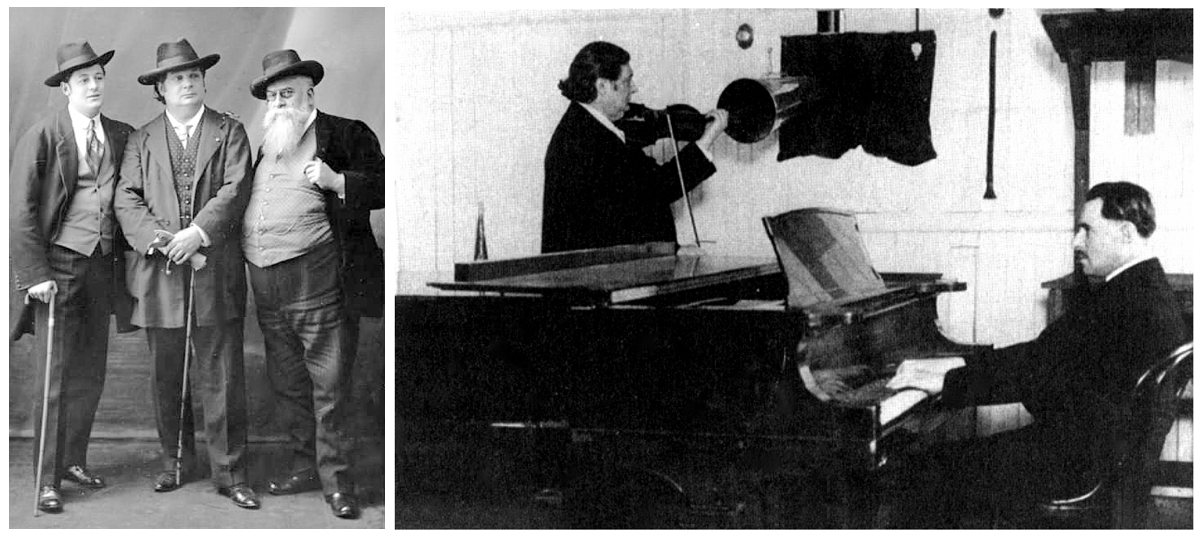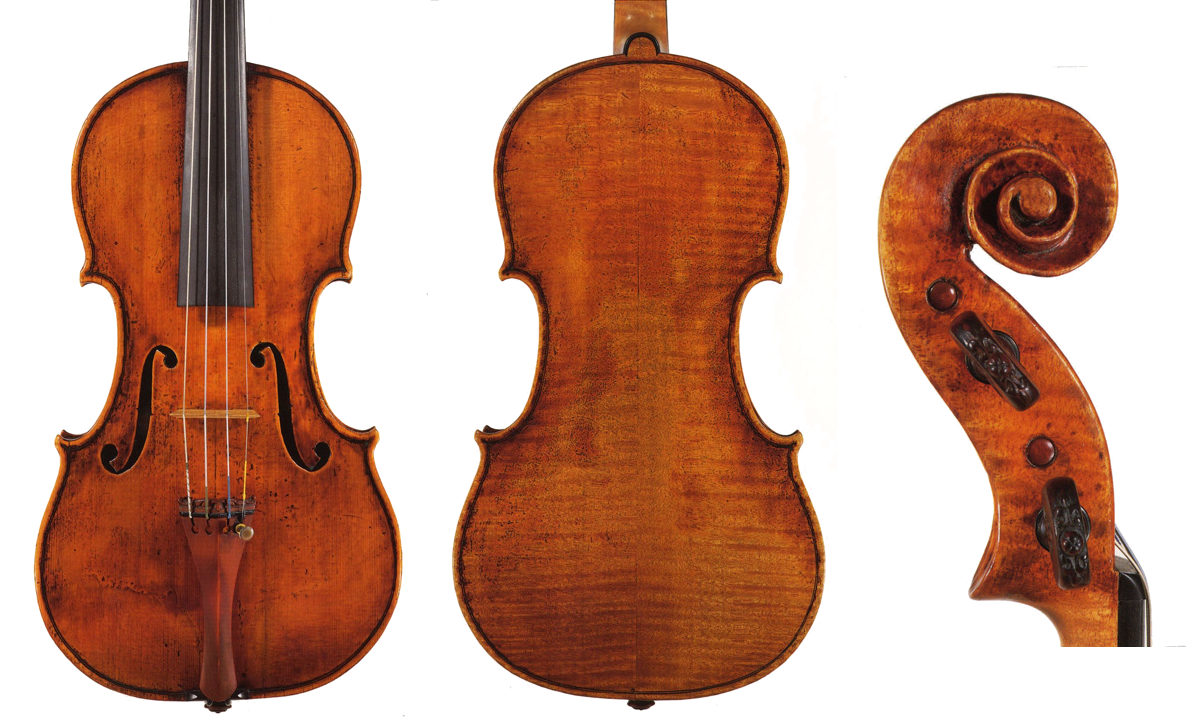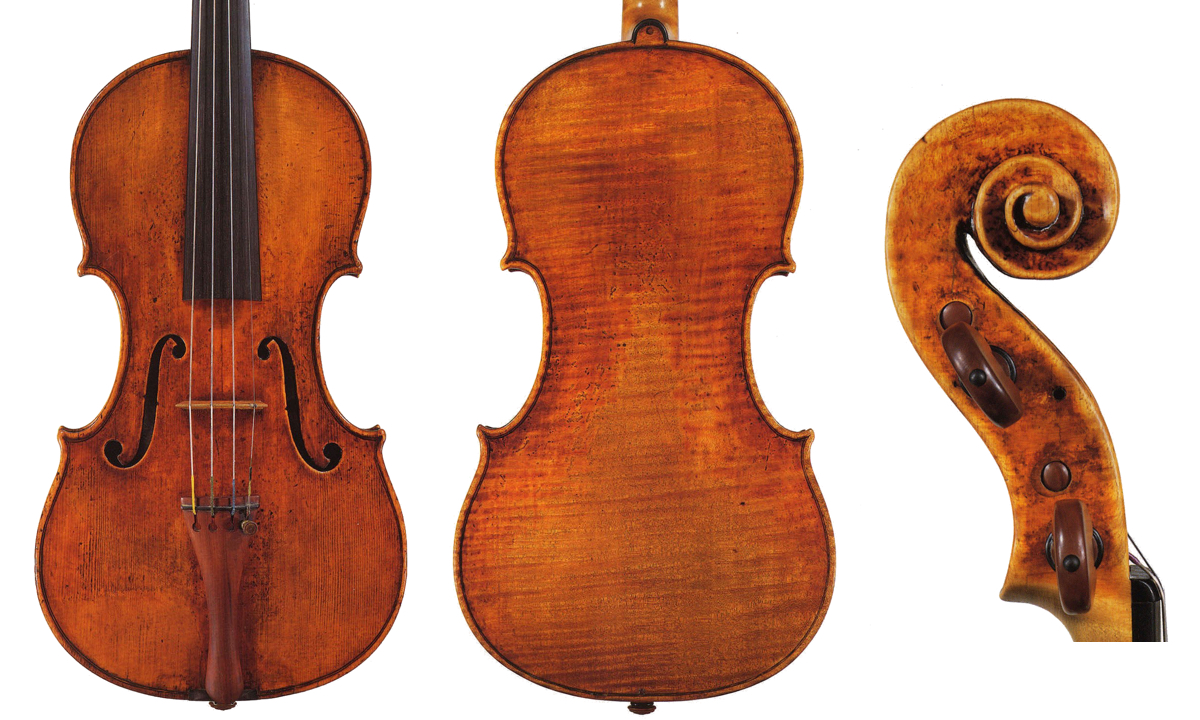As the greatest champion of the Franco-Belgian school at the end of the 19th century and the beginning of the 20th, Eugène Ysaÿe (1858–1931) played an array of suitably fine instruments.
He managed to start his solo career on an excellent 1754 violin by G.B. Guadagnini, which he loved very much. The story of how he acquired it has no doubt been romanticized over the years, but here it is: Ysaÿe saw this fiddle in the window of a pawnbroker’s shop in Hamburg, and coveted it but had no money. A friend from Belgium who worked as a diamond dealer happened to visit him, and Ysaÿe persuaded him to leave a bag of gemstones as security for the violin. ‘In this way,’ Ysaÿe said, ‘I was married to my first love among the fiddles – my beautiful Guadagnini.’ [1] He used it until 1895. The violin bears a Turin label from 1774, but experts date it to 1754 in Milan. The instrument, played by Ralph Hollander from 1974 to 2006, still does service at the Juilliard School.

Ysaÿe in Russia in 1883
In Genoa on April 30, 1889 Ysaÿe was able to give a recital on Paganini’s ‘Cannon’ Guarneri ‘del Gesù’. Unbeknown to him, his impresario thrice offered to buy the violin for him as a publicity stunt! The ‘Cannon’ was not for sale, but the affair may well have sown the seed of Ysaÿe’s love for this maker. On his first visit to London in 1891, Ysaÿe visited Hill’s in Bond Street and was shown a Strad and a 1741 Guarneri ‘del Gesù’ – ‘each had been used by my old master Vieuxtemps,’ he wrote to his wife, Louise. ‘By paying a small insurance premium I was able to borrow the Guarnerius for a few days and I am now using this colossus. You can imagine my joy. I have never had such a wonderful feeling. The instrument seems capable of every shade of feeling from drama to romance. Its tone is immense. I played some Vieuxtemps on it and it seemed to me that the violin itself was made happy by the memories the music stirred up.’ [2] Unable to afford the 25,000-franc price tag, he had to return it, but by coincidence it was later acquired by his pupil Philip Newman, who can be heard playing it on a CD (Symposium 1327). Newman famously played it to Ysaÿe when the master was dying.
‘I was able to borrow the Guarnerius for a few days and I am now using this colossus. You can imagine my joy’ – Ysaÿe
The London encounter fired Ysaÿe’s enthusiasm for the violins of Guarneri ‘del Gesù’ and for his 1894 debut tour of America he was able to borrow one from his Royal Brussels Conservatoire pupil Carry Messe. ‘Carry’s violin is simply marvellous and if I had to return it now I should probably have an attack of jaundice,’ he reported home. In the event, he was able to beg or bully Messe into letting him buy the violin, ‘leaving her the Guadagnini and 40,000 francs … as well as his brother Théophile as a husband’ as his son later wrote, tongue-in-cheek. [3] This 1740 instrument, with a finely figured one-piece back, became indelibly associated with him and is now known as the ‘Ysaÿe’. On it he gave many premieres as well as his first performance of the Beethoven Concerto, in 1900. In 1928, when the luthier Joseph Hel of Lille had it for running repairs, Ysaÿe asked for a label to be inserted saying ‘Ce del Gesù fut le fidéle compagnone de ma vie – Eugène Ysaÿe 1928’ [4] and asked Hel to place it next to the original label. Isaac Stern, who had the violin from 1965 to 1998, wrote in his memoirs: ‘I shall add an additional label: “La mienne aussi” (Mine too).’ [5] It is now owned by Japan’s Nippon Foundation.
We can be confident that Ysaÿe used the Guarneri ‘del Gesù’ for his recordings, which were made at Columbia Studios in the Woolworth building, lower Manhattan, in December 1912 and February and March 1913. He was partnered by the distinguished French pianist Camille Decreus. Although Ysaÿe’s playing had begun to decline, he still sounds wonderful: all we miss is his famous power – he seems to have understood that a record was something intimate. Particularly noticeable to today’s violinists will be his beautiful, silvery vibrato and his lovely portamento. The great violinist’s favorite was the Mendelssohn Concerto finale, full of vim, vigor and virtuosity. My own favorite is Fauré’s ethereal Berceuse.

Left: Eugène Ysaÿe (center) with his brother Théo (left) and the French composer Raoul Pugno. Right: Ysaÿe with Camille Decreus in the Columbia studios in 1912. He almost certainly used his 1740 Guarneri for these recordings
In 1895 Ysaÿe acquired another great fiddle, the 1734 ‘Hercules’ Stradivari, which shared a double case with the Guarneri. ‘Although it possessed a warm and powerful sonority, Ysaÿe usually chose his Guarneri for his concert-work since it was very much less fatiguing to play and also because he found that it was more responsive, in most conditions, to his temperament,’ his son wrote. [6] On a visit to St Petersburg in 1908 he was playing the Guarneri on stage at the Imperial Theatre when the ‘Hercules’ was stolen from the Green Room. Somehow it reached a Parisian dealer in 1925, was acquired for Carl Münch (Charles Munch) by his wife and in 1962 was bought for $40,000 by Henryk Szeryng. In 1972 Szeryng gave it to the city of Jerusalem – where it is known as the ‘Kinor David’ (Lyre of David) – for use by the concertmasters of the Israel Philharmonic.
‘Very few violinists can play viola… Ysaÿe was one of the few’ – William Primrose
Among Ysaÿe’s other violins were a 1720 Giuseppe Guarneri ‘filius Andreae’, an 1820 Lupot, an 1827 Vuillaume now known as the ‘Ysaÿe’, two more Vuillaumes dated 1852 and 1862, and a 1788 François-Louis Pique of Paris, which was also owned by Jacques Thibaud and bears both violinists’ signatures as well as the original label. Henry Roth mentions ‘a Maggini, a superb Georges Chanot (a copy of his del Gesù), and several outstanding French violins’ as well. [7]
As a great chamber music player and quartet leader who enjoyed Hausmusik, Ysaÿe needed at least one viola, and he had a 1740 Testore. He felt strongly that the instrument should not be looked down upon. ‘Very few violinists can play viola,’ said his pupil William Primrose. ‘Ysaÿe was one of the few. His style of bowing and his unique system of fingering amply qualified him. It was always my favourite instrument, but everyone was against my making what was regarded at that time as a retrograde (if not abasing!) step. My great Master was the one to perceive where my love and talent resided and filled me with courage and encouragement to cross the Rubicon!’ [8] Primrose studied with Ysaÿe on and off for some three years beginning in 1926, mostly in the summers at his seaside villa La Chanterelle in Le Zoute sur Mer but also occasionally during the winter at the Avenue Brugmann in Brussels. ‘Evenings at Le Zoute were frequently devoted to chamber music,’ he wrote in his memoirs. ‘It was at one of these soirées that Ysaÿe suggested I should switch to viola. He seemed to indicate that I had some special aptitude for it. I’ve often wondered how much that opinion was engendered by a desire to have a violist at hand for his quartet evenings.’ [9] No doubt Primrose played the Testore on such domestic occasions.

The Sartory bow given to Ysaÿe by his friend and pupil Queen Elisabeth of Belgium
Ysaÿe had an extremely large collection of bows, including two especially fine examples that were later acquired by Isaac Stern: a gold-and-tortoiseshell-mounted F.X. Tourte violin bow with an octagonal stick; and a gold-mounted Sartory viola bow with the ferrule engraved ‘Specialement fait pour M. Ysaÿe’. Ysaÿe clearly valued the work of Sartory and also owned a violin bow engraved with the date 1928 and the legend ‘Specialement fait pour E. Ysaÿe’; it is now named after him, as is another Sartory violin bow, which was a Christmas gift in 1929 from his friend and pupil, Queen Elisabeth of the Belgians: it comes with a letter from the queen dated November 21, 1929. Another ex-Ysaÿe bow is a particularly fine François Peccatte engraved ‘EY’ to the ferrule.
Tully Potter is a journalist and music critic. He is a regular contributor to various international music journals and has written a biography of Adolf Busch.
Notes
[1] The Etude, September 1909, p. 634; reprinted from Music, 1902.
[2] Antoine Ysaÿe & Bertram Ratcliffe, Ysaÿe, William Heinemann Ltd, London, 1947, p. 69.
[3] Antoine Ysaÿe, Ysaÿe, W.E. Hill & Sons, Great Missenden, 1980, p. 62. Ysaÿe’s brother Théo, a pianist and composer, did indeed marry Carry Messe.
[4] ‘This del Gesù has been the faithful companion of my life.’
[5] Isaac Stern with Chaim Potok, My First 79 Years, Alfred A. Knopf, New York, 1999, p. 135.
[6] Henry Roth, Violin Virtuosos, California Classics Books, Los Angeles, 1997, p. 22.
[7] Henry Roth, Op. cit, p. 22.
[8] Antoine Ysaÿe, Op. cit., p. 201.
[9] William Primrose, Walk on the North Side: Memoirs of a Violist, Brigham Young University Press, Provo, Utah, 1978, p. 59.

